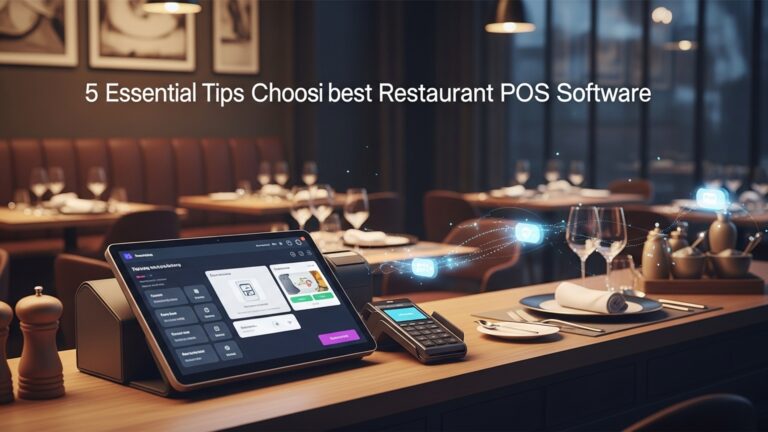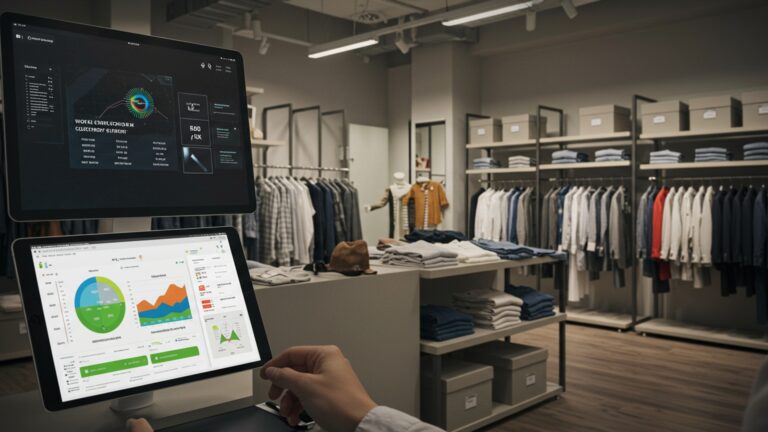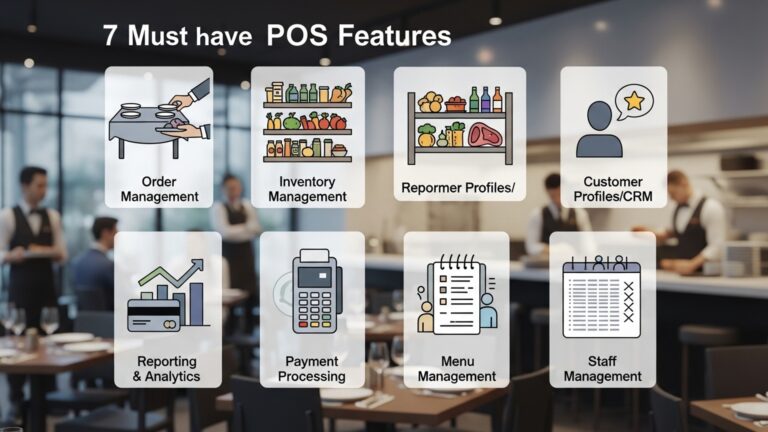How to Streamline Restaurant Operations Using POS Software and a KDS Guide
The modern restaurant landscape demands unparalleled efficiency, where traditional paper tickets and shouted orders often lead to bottlenecks, errors. frustrated patrons. Embracing integrated POS software with kitchen display system (KDS) emerges as the critical strategy to transform these operational challenges into seamless workflows. This powerful synergy instantly transmits orders from the front-of-house to the back-of-house, virtually eliminating miscommunication and ensuring precise order fulfillment. Consider the escalating demands of third-party delivery services and dine-in experiences; a KDS dynamically prioritizes dishes, optimizing prep times and enhancing overall kitchen throughput. Such technological adoption not only boosts table turns and reduces food waste but also empowers staff to deliver consistent, high-quality service in real-time.
Understanding the Foundation: Point-of-Sale (POS) Software
In the dynamic landscape of restaurant operations, efficiency and precision are paramount. At the heart of a modern restaurant’s digital ecosystem lies the Point-of-Sale (POS) software. Far more than just a cash register, a robust POS system is a comprehensive management tool designed to streamline every aspect of customer transactions and back-of-house operations.
What is POS Software?
POS software is a centralized system that records sales, tracks inventory, manages customer data. facilitates various administrative tasks. When a customer places an order, the POS system processes the transaction, calculates costs, applies discounts. handles payment processing. Its primary function extends beyond sales, integrating critical data from across the business to provide a holistic view of performance.
- Order Management
- Payment Processing
- Inventory Tracking
- Sales Reporting
- Customer Relationship Management (CRM)
- Employee Management
Taking orders accurately, customizing items. applying modifiers.
Handling various payment types including cash, credit cards, mobile payments. gift cards.
Monitoring ingredient levels, alerting staff to low stock. assisting with reordering.
Generating detailed reports on sales trends, popular items, peak hours. staff performance.
Storing customer data for loyalty programs, personalized offers. feedback collection.
Tracking shifts, tips. payroll data, often with integrated time clocks.
For instance, imagine a bustling Friday night. A server quickly inputs an order for a “gluten-free pasta with extra sauce, no onions” into the POS. The system not only processes the payment but also immediately communicates these specific instructions to the kitchen, ensuring the customer’s exact preferences are met without manual transcription errors. This real-time data flow is foundational to operational excellence.
Introducing the Kitchen Display System (KDS): The Digital Heart of the Kitchen
While POS software handles the front-of-house, the Kitchen Display System (KDS) revolutionizes the back-of-house, acting as the digital command center for food preparation. Replacing traditional paper tickets and shouted orders, a KDS is a digital screen (or multiple screens) that displays incoming orders directly to kitchen staff.
What is a KDS?
A KDS receives orders from the POS system and presents them clearly and dynamically to the kitchen. It organizes orders, tracks preparation times. facilitates communication among different kitchen stations (e. g. , grill, fryer, expediting). This digital transformation eliminates the clutter and potential for error associated with paper-based systems, ensuring every order is seen, prioritized. prepared efficiently.
- Digital Order Display
- Timed Order Tracking
- Station Routing
- Bump Screen Functionality
- Performance Analytics
Orders appear instantly on screens, often color-coded by status or preparation time.
Monitors how long each order has been in the kitchen, highlighting overdue items.
Automatically sends specific components of an order to the relevant prep station (e. g. , burger to grill, fries to fryer).
Kitchen staff can “bump” or mark items/orders as completed with a touch or button press.
Gathers data on prep times, bottlenecks. kitchen efficiency.
Consider a multi-course meal. The KDS can hold certain items until others are ready, ensuring all dishes for a single table are prepared and served concurrently, rather than having appetizers sit cold while entrees are still cooking. This level of orchestration is nearly impossible with paper tickets.
The Power of Integration: POS Software with Kitchen Display System
The true magic in streamlining restaurant operations happens when POS software and a KDS are seamlessly integrated. This powerful combination creates a unified digital workflow, from the moment a customer places an order to when the dish is served. A well-implemented POS software with kitchen display system integration transforms a restaurant from a collection of siloed departments into a cohesive, high-performing unit.
When an order is entered into the POS, it doesn’t just print a ticket; it’s instantly transmitted to the appropriate KDS screens in the kitchen. Special requests, modifications. timing notes are clearly displayed, reducing miscommunication and errors. This real-time, bidirectional flow of insights is the cornerstone of modern restaurant efficiency.
Real-World Application: A Busy Lunch Rush
Imagine a scenario at “The Urban Bistro,” a trendy downtown eatery. During peak lunch hour, a server uses their handheld POS device to take an order for Table 7: two “Classic Burgers” (one medium-rare, no pickles; one well-done with extra cheese), a “Caesar Salad,” and a “Soup of the Day.” As the server taps “Send Order” on the POS, the following occurs:
- The burger orders immediately appear on the “Grill Station” KDS screen, showing cooking preferences.
- The salad order appears on the “Salad Prep” KDS screen.
- The soup order appears on the “Expediter” KDS screen, or directly on the “Soup/Appetizer” screen.
- The KDS color-codes the order, perhaps in yellow, indicating it’s new. As time passes, it might turn orange, then red, to signal urgency.
- Once the grill cook finishes the burgers, they “bump” them off their KDS screen. The expediter’s screen updates, showing the burgers are ready.
- The expediter coordinates with the salad and soup stations, ensuring all items for Table 7 are ready simultaneously for optimal freshness and presentation.
This integrated approach ensures transparency, accountability. speed across the entire order fulfillment process, drastically cutting down on wait times and order inaccuracies, a common pain point for diners.
Key Benefits of Integrating POS and KDS
The synergy between POS software and a KDS delivers a multitude of operational advantages that directly impact profitability, customer satisfaction. staff morale.
- Enhanced Order Accuracy
- Faster Service and Table Turns
- Improved Kitchen Communication
- Reduced Food Waste and Cost
- Better Staff Accountability and Performance Tracking
- Streamlined Workflow and Reduced Stress
- Data-Driven Decision Making
Digital transmission eliminates human error from misreading handwritten tickets or mishearing shouted orders. Special requests and modifications are clearly displayed.
Real-time communication accelerates kitchen workflows, reducing preparation times and allowing for quicker table turnover, especially crucial in high-volume establishments.
Orders are routed directly to specific stations, minimizing confusion and ensuring each chef knows exactly what to prepare and when. Color-coding and timers provide visual cues for prioritization.
Accurate order transmission and better inventory tracking (via POS) lead to fewer mistakes, less wasted food. more precise ingredient management. The KDS can also highlight items that have been in the kitchen too long, prompting action.
Both systems provide data on order times, individual staff performance. overall kitchen speed, allowing managers to identify training needs or reward efficiency.
By digitizing and automating processes, staff can focus on food quality and customer service rather than manual data entry and communication.
The integrated system captures a wealth of data, from sales trends to prep times. This details is invaluable for menu optimization, staffing decisions. identifying operational bottlenecks.
Core Features to Look for in a POS Software with Kitchen Display System
When investing in a POS and KDS solution, it’s crucial to select systems that offer robust features and seamless integration. Here’s what to prioritize:
- Intuitive User Interface (UI)
- Customizable Order Routing
- Real-time Updates and Syncing
- Multiple Display Options
- Menu Management Integration
- Reporting and Analytics
- Offline Mode Capability
- Integration with Third-Party Platforms
- Scalability
- Robust Security Features
Both the POS and KDS should be easy for staff to learn and operate, minimizing training time and errors.
The KDS should allow you to define how orders are routed to different kitchen stations based on your menu and kitchen layout.
Any changes made on the POS (e. g. , voiding an item, adding a modifier) should instantly reflect on the KDS.
The KDS should support various screen sizes and types (touchscreen, bump bar controlled) to fit different kitchen environments.
Changes to menu items, pricing, or availability in the POS should automatically update across the KDS.
Comprehensive reports on sales, inventory, prep times. staff performance are essential for continuous improvement.
Crucial for ensuring operations continue even if internet connectivity is temporarily lost.
Consider integration with online ordering platforms, delivery services. loyalty programs for a truly omnichannel experience.
The system should be able to grow with your business, whether you add more stations, locations, or expand your menu.
Protecting sensitive customer and business data is non-negotiable.
Comparing Traditional vs. Digital Kitchen Workflows
To fully appreciate the impact of a POS software with kitchen display system, it’s helpful to compare the old way of doing things with the modern approach:
| Feature | Traditional (Paper Tickets) | Digital (POS + KDS) |
|---|---|---|
| Order Transmission | Handwritten or printed tickets carried by servers; shouted orders. | Instantaneous digital transmission from POS to KDS screens. |
| Order Clarity | Prone to misreading handwriting, smudges, lost tickets. | Clear, legible digital display; modifications highlighted. |
| Communication | Verbal communication, often loud and chaotic. | Visual cues, timed alerts, station-specific routing. |
| Tracking & Timing | Manual clocking, guesswork, difficult to track individual items. | Automated timers, color-coding for urgency, historical data on prep times. |
| Error Reduction | High potential for human error in transcription or delivery. | Significantly reduced errors due to digital accuracy. |
| Waste Reduction | More prone to incorrect orders leading to wasted food. | Fewer errors, better inventory control leads to less waste. |
| Kitchen Environment | Cluttered with paper, often stressful and noisy. | Clean, organized, calmer. more efficient. |
| Data & Analytics | Minimal data capture, relies on manual observation. | Rich data on performance, bottlenecks. trends. |
Actionable Takeaways for Implementation and Optimization
Adopting a POS software with kitchen display system is a strategic move that requires careful planning and execution. Here are actionable steps to ensure a successful transition:
- Assess Your Current Needs
- Research and Demo Multiple Systems
- Phased Rollout (If Applicable)
- Comprehensive Staff Training
- Customize to Your Workflow
- Monitor and Optimize
- Gather Feedback
- Leverage Analytics
- Regular Maintenance and Updates
Before investing, conduct a thorough analysis of your current operational bottlenecks, menu complexity. kitchen layout. This will help you identify the specific features and integrations you need.
Don’t settle for the first option. Request demonstrations from several reputable POS and KDS providers. Pay attention to user-friendliness, customization options. customer support. Ask for references from similar restaurants.
For larger establishments, consider a phased implementation. Start with core POS functionalities, then integrate the KDS. gradually introduce advanced features like inventory management or online ordering.
This is critical. Invest in thorough training for all staff – front-of-house (servers, cashiers) and back-of-house (chefs, expeditors). Ensure they grasp not just how to use the system. why it benefits them and the restaurant. Role-playing and hands-on practice are invaluable.
Configure the KDS to mirror your kitchen’s unique workflow. Set up specific routing rules for different stations, customize screen layouts. define bump bar functions that make sense for your team.
Post-implementation, continuously monitor performance metrics. review KDS data for average prep times, identify peak periods. pinpoint any recurring bottlenecks. Use POS reports to cross-reference sales data with kitchen efficiency.
Regularly solicit feedback from your staff. They are on the front lines and can provide invaluable insights into how the system can be improved or if any adjustments are needed.
The data generated by your integrated POS and KDS is a goldmine. Use it to refine your menu, optimize staffing levels, identify popular dishes. improve overall operational efficiency. For example, if your KDS shows consistently long prep times for a specific dish, you might re-evaluate its ingredients or process.
Keep your software updated to benefit from new features, security enhancements. bug fixes. Regularly check hardware (screens, bump bars) for wear and tear.
By following these guidelines, restaurants can effectively harness the power of an integrated POS and KDS to create a streamlined, efficient. profitable operation that consistently delivers exceptional customer experiences.
Conclusion
The seamless integration of POS software and a KDS isn’t merely an upgrade; it’s a strategic transformation, forging a synchronized heartbeat for your restaurant. Gone are the days of deciphering smudged tickets or shouting orders; instead, visualize the silent efficiency of a KDS displaying a ‘no onions’ customization instantly, preventing costly errors and ensuring customer delight – a common friction point I’ve personally witnessed vanish from kitchens. This powerful duo empowers you to manage everything from nuanced order modifications to peak-hour kitchen flow with unprecedented clarity and speed, truly reflecting current trends in data-driven hospitality. To fully harness this potential, my personal tip is to treat your system as a living tool, not just a one-time installation. Regularly review your KDS bump screen analytics – how long orders sit, which stations are bottlenecks – and use these insights to fine-tune your workflow. For instance, the recent surge in third-party delivery orders highlights the need for a KDS that seamlessly aggregates these alongside dine-in requests, streamlining operations rather than adding complexity. This proactive approach not only boosts efficiency but also significantly enhances staff morale by reducing pressure and miscommunication. Embrace this digital evolution, not as an expense. as an investment in agility and excellence. When you empower your team with intuitive tools, you’re not just streamlining operations; you’re building a resilient, profitable business ready to thrive in any market condition. Take the next step towards operational mastery and watch your restaurant flourish.
More Articles
Tutorial 10 Best Practices for Smooth Restaurant POS System Implementation
Master 5 Smart Strategies to Boost Restaurant Efficiency Using Your POS
How to Select the Best Restaurant POS System Essential Features Guide
Guide 10 Best Practices for Optimizing Your Restaurant POS Performance
Learn 7 Ways Restaurant POS Software Boosts Your Business Efficiency
FAQs
What’s the big deal about using POS software and a KDS in my restaurant?
Simply put, they work together to make everything run much smoother. POS handles orders, payments. front-of-house tasks, while the Kitchen Display System (KDS) sends those orders straight to the kitchen. This cuts down on errors, speeds up service. generally makes your operation more efficient from start to finish.
How does POS software actually help my front-of-house staff?
Your servers will love it! POS software makes taking orders super fast and accurate, managing tables a breeze. processing payments quick and easy. It minimizes mistakes from handwriting or miscommunication, leading to a much better experience for both staff and customers.
And what about the kitchen? How does a KDS make things smoother there?
For the kitchen crew, a KDS is a game-changer. Instead of messy paper tickets, orders appear clearly on a screen. Chefs can see new orders instantly, prioritize tasks, mark items as complete. even communicate with other stations. It helps manage cook times, reduces waste. keeps everyone on the same page, leading to faster and more accurate food prep.
How do the POS and KDS systems work together to streamline operations?
It’s a seamless dance! When a server takes an order on the POS, it’s immediately sent to the KDS in the kitchen. As items are prepared, the kitchen updates their status on the KDS, which can then be seen by the front-of-house staff on their POS terminals. This real-time communication ensures everyone knows exactly what’s happening with every order, from placement to pickup.
Will using these systems really make my customers happier?
Absolutely! Faster order taking, fewer mistakes, quicker food delivery. more efficient payment processing all add up to a significantly better dining experience. Happy customers are more likely to return and recommend your restaurant.
Can POS and KDS help me keep track of my inventory and control costs better?
Yes, indirectly and directly. Your POS system tracks every sale, giving you valuable data on what’s popular and what’s not, which helps with ordering and inventory planning. While the KDS primarily manages kitchen workflow, its efficiency reduces food waste due to errors or over-preparation, contributing to better cost control. Many POS systems also have direct inventory management features.
Is it tough to get my staff up to speed with new POS and KDS systems?
Modern POS and KDS systems are designed with user-friendliness in mind, often featuring intuitive touchscreens and simple interfaces. While there’s always a learning curve with new technology, proper training and a good system can have your staff proficient in a relatively short time, unlocking the benefits quickly.




